Sustainably Preserving the Past - City of Houston Central Permitting Center

Restoring and reusing an existing building is an exemplary act of sustainability in the built environment. It reduces construction waste and sometimes can be extremely cost effective. For the City of Houston, it made economic and environmental sense when they chose to renovate an 86-year-old former rice warehouse near downtown to consolidate their Administration and Regulatory Affairs (ARA) and Public Works and Engineering (PWE) permitting operations under one roof. This new Central Permitting Center will also house the city’s Green Building Resource Center, an extension of PWE that shares sustainable energy saving strategies with the public.
Studio RED Architects, Haynes Whaley Associates Structural Engineers and Manhattan Construction Company were chosen as the project team to lead the renovation. As the waterproofing and masonry restoration subcontractor to Manhattan, Chamberlin performed new construction and remediation work to restore the 187,000 sq. ft. building.
The masonry restoration scope of work included brick, clay tile and CMU replacement and exterior building cleaning and coating. Chamberlin removed paint, graffiti and mastic to expose the original red brick in several locations. To protect the building from further vandalism, an anti-graffiti sealer was applied to the lower exterior levels with traditional waterproof coatings on upper elevations.

To provide structural reinforcement Chamberlin installed approximately 625 lineal feet of epoxy injection to strengthen cracks in load bearing basement walls. The team also replaced damaged concrete, repaired concrete columns, cleaned and sealed structural metal and repaired concrete window head beams.
The window head beam repairs were challenging because of the unforeseen conditions that became apparent during the demolition phase,” said Chamberlin Senior Project Manager, Jonathan Winkles. “We were also very safety conscious because large pieces of concrete could potentially fall when removed, so we created a failsafe method of containing debris.”
To overcome the safety challenges of removing large pieces of concrete from window head beams, the Chamberlin safety department constructed a rolling scaffold platform for craftsmen on the interior of the building to correspond with their counterparts working from the exterior on swing stages. The platforms were tied off to structural columns and secured with weights so Chamberlin team members could safely remove and replace overhead concrete around the windows.
It was a real team effort,” said Chamberlin Superintendent, Mike Hicks. “Each window restoration required a team of two people – one working on an exterior swing stage and the other providing support from the interior of the building.” Plywood was strategically placed between the swing stage and window to further protect other tradesmen below from possible loose concrete.

Because of its deterioration, Chamberlin removed approximately 200% more concrete around the windows than initially estimated. “That is the nature of restoration projects,” said Winkles, “you sometimes don’t know the full extent of work required until you start digging in, so it becomes important to be able to provide solutions on the spot for existing conditions.”
A 3,750 sq. ft. curtainwall construction addition was built on to the existing structure as a public entry into the permitting center along with new fire exit stair towers on the east and north sides of the building. Chamberlin installed terrazzo-filled expansion joint assemblies on the first floor to connect the two buildings. When it came time to install the interior two and one-half inch joint, though, Chamberlin discovered the existing floor level was not exactly flush with the new one. Because of its unevenness, the existing floor height difference ranged from one-quarter inch to over two inches in some areas. To remedy the difference, Chamberlin made a 12 gauge steel plate with a two inch riser, which was slowly filled with concrete to square off and build up the existing floor. Once both surfaces were uniform, Chamberlin installed the joint, which was filled with terrazzo to seamlessly match the floor’s new finish.
This building was built to last,” said Winkles, “You don’t see these types of construction means and methods used anymore, so it provided a history lesson of sorts during its restoration. For example, exterior walls are three bricks wide, rebar is squared and twisted and structural concrete columns are cone-shaped at the top.

Though the building needed a little more TLC than expected, all teams worked together to find the best possible solutions. The interior of the building was largely left in its original state for aesthetic value. Structural repairs were made where necessary, but brick walls, concrete columns and ceilings were left exposed providing a raw, historic look.
The project is seeking LEED Silver status, which fulfills the City of Houston’s Green Building Resolution target for all new construction and renovated buildings owned by the city that are over 10,000 sq. ft.
As architect, Pete Ed Garrett of Studio RED Architects, wrote in his recent article in the Houston Business Journal, “… in essence, recycling buildings through renovation is one of the most sustainable things we can do... the added bonus is that Houston can demonstrate that it cares about its buildings, their stories and its soul.”
Subscribe Today!
Stay-in-the-know and subscribe to our blog today!